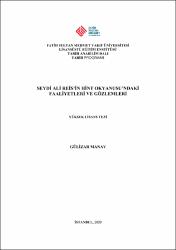Seydi Ali Reis'in Hint Okyanusu'ndaki Faaliyetleri ve Gözlemleri
Citation
MANAV, Gülizar, Seydi Ali Reis'in Hint Okyanusu'ndaki Faaliyetleri ve Gözlemleri, Fatih Sultan Mehmet Vakıf Üniversitesi Lisansüstü Eğitim Enstitüsü Tarih Anabilim Dalı, Yayımlanmamış Yüksek Lisans Tezi, İstanbul 2020.Abstract
1517 yılında Mısır’ın Osmanlı topraklarına katılmasıyla Osmanlı İmparatorluğu’nun etki alanları genişlemiştir. Osmanlı İmparatorluğu, artık Kızıldeniz ve Hint Okyanusu’nda da varlığını göstermeye başlamıştır. 1498’de Ümit Burnu’nu keşfeden Portekizliler, akabinde Hint Okyanusu’na ulaşıp burada tehdit edici bir güç olmuşlardır. Portekiz’in, Hint Okyanusu’nda faaliyet göstermesinden ve Müslümanlara karşı tehlike oluşturmasından dolayı bu durumu kontrol altına almak isteyen Osmanlı İmparatorluğu, Portekiz ile Hint Okyanusu’nda hakimiyet mücadelesine girerek karşı karşıya gelmiştir.
16. yüzyılda Hint Okyanusu’ndaki bu rekabette Portekizliler ile girişilen mücadelede Pîrî Reis’in Basra’da bırakmak zorunda kaldığı donanmayı Süveyş’e getirmek için Osmanlı bilgini ve denzicilerinden Seydi Ali Reis, 2 Aralık 1553 Mısır Kaptanlığına getirilerek, görevlendirilmiştir. Ancak Seydi Ali Reis de hem Portekiz ile yaşadığı çarpışmalar neticesinde hem de Fil tufanına yakalanmasıyla donanmayı Süveyş’e getirememiştir.
Portekiz, bu olayların akabinde Seydi Ali Reis’in, Hint Okyanusu’ndan Osmanlı topraklarına gitmesine müsaade etmemiştir. Seydi Ali Reis de kara yoluyla Osmanlı topraklarına dönmeye karar vermiştir. Böylece 3 yıl yedi ay süren maceralı bir yolculuk yaşayan Seydi Ali Reis, bu yaşadıklarını Mir’âtü’l-Memâlik adlı eserinde kaleme almıştır. Bunun yanında deniz astronomisi ve fiziki coğrafya ile ilgili olan Kitâbü’l-Muhît fî-İlmi’l-Eflâk ve’l-Ebhur adlı eserinde de Hint Okyanusu’da edindiği gözlemleri aktarmıştır.Bu tezde, Seydi Ali Reis’in Hint Okyanusu’na yapmış olduğu sefer ve akabinde Hint Okyanusu coğrafyasında yaşadığı yolcukta edindiği bilgiler, gözlemler ve şahit olduğu olaylar Mir’âtü’l-Memâlik ve Kitâbü’l-Muhît fî-İlmi’l-Eflâk ve’l-Ebhur eserleri çerçevesinde, güncel araştırmalar da incelenerek değerlendirilmiştir. . In 1517 with the addition of Egypt to the Ottoman lands, the influence areas of the Ottoman Empire expanded. The Ottoman Empire started to show its presence in the Red Sea and the Indian Ocean. The Portugueses discovering the Cape of Good Hope in 1498 subsequently reached the Indian Ocean and became a threatening force there. Because of Portugueses' activity in the Indian Ocean and creating a danger against Muslims, The Ottoman Empire wanted to take control of this situation and came face to face with Portuguese in the Indian Ocean.
In the 16th century in order to bring the navy that Pîrî Reis had to leave in Basra in the fight with the Portuguese in the Indian Ocean, Seydi Ali Reis, one of the Ottoman scholars and sailors, was appointed as the Egyptian Captain on 2 December 1553. However, Seydi Ali Reis could not bring the navy to Suez either because of the clashes with Portuguese and the Fil Flood he was caught.
After these events Portuguese did not allow Seydi Ali Reis to go to the Ottoman lands from the Indian Ocean. Therefore, Seydi Ali Reis decided to return to the Ottoman Territories by land. Thus, Seydi Ali Reis, who had an adventurous journey lasting 3 years and seven months, wrote these experiences in his book called Mir’âtü’l-Memâlik. In addition, he shared his observations in the Indian Ocean in his book titled Kitâbü'l-Muhît fî-İlmi'l-Eflâk ve'l-Ebhur, which is about marine astronomy and physical geography.
In this thesis, the voyage of Seydi Ali Reis to the Indian Ocean and subsequently the information, observations and events he witnessed on his journey in the geography of the Indian Ocean are evaluated by examining the current researchesand within the framework of works of Mir’âtü’l-Memâlik and Kitâbü'l-Muhît fî-İlmi’l-Eflak and'l-Ebhur.



















